Brunost
Norwegen-Käse
OPPSKRIFT
Lagt inn den 24.09.2003
Sendt inn av Magnús ®&Mac173;ór Magnússson
Brunost
5 liter melk
sukker
litt smør
Brunost - a Norwegian treasure

http://www.aftenposten.no/english/bildeserier/article458116.ece?start=10
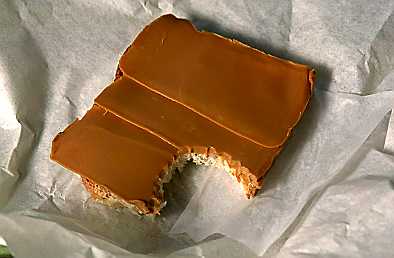
One of the most common sights in Norway for generations - an open brunost - brown cheese - sandwich wrapped in wax paper.
PHOTO: Rolf Aagaard
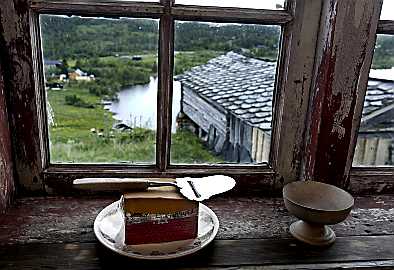
A timeless view from Gålå, in Gudbrandsdalen. This area is the cradle of brown cheese, and the home of exported brunost.
PHOTO: Knut Snare
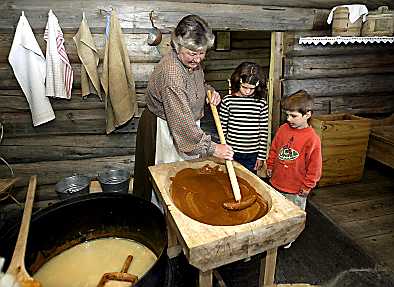
Randi Solbraa, her with grandchildren Anne and Ola, makes brown cheese for summer tourists in Gudbrandsdalen.
PHOTO: Knut Snare
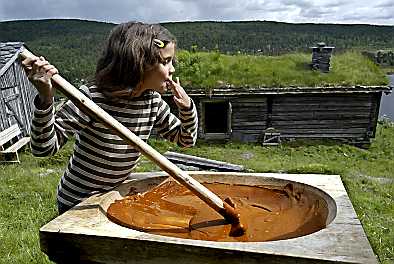
Anne Solbraa (7) tastes brunost in progress.
PHOTO: Knut Snare

Olympic biathlon star Ole Einar Bjørndalen, here at the Winter Games in Salt Lake City, shows again that Norwegians can't leave home without it.
PHOTO: Knut Snare
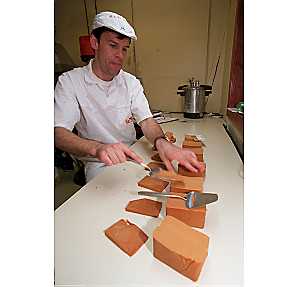
Even Sugaren from the local Folldal Dairy, carries out taste tests on every brunost batch produced.
PHOTO: Jon Hauge
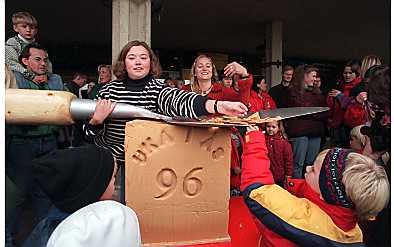
The world's largest brunost is unveiled at the UKA culture festival in Ås, in 1996.
PHOTO: Tone Georgsen
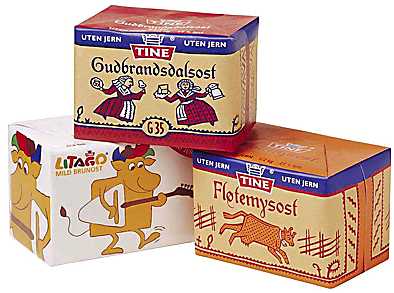
A sampling of brunost from dairy giant Tine.
PHOTO: null
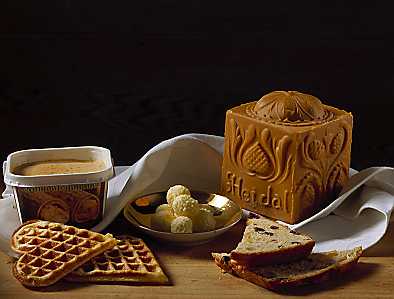
Brunost can also be formal, here a fancy mold produces an elaborate cheese, destined for use on ... waffles.
PHOTO: SCANPIX
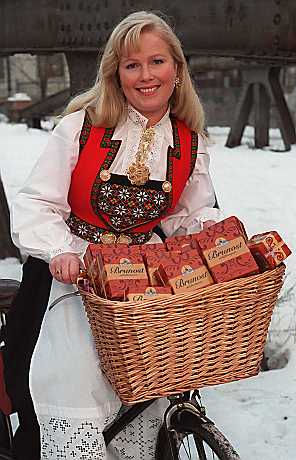
Anne K. Hindaker in a pose paying tribute to the original Synnøve Finden, who started her dairy with bicycle deliveries.
PHOTO: Terje Bendiksby
Brunost - Norwegian Brown Cheese
http://www.bbc.co.uk/dna/h2g2/alabaster/A823024
"Have some of this, it's good." The Norwegian hands you an open faced sandwich with a slice of something redish brown, "it's 'Brunost', brown cheese."
It doesn't look like cheese, you think, but it can't be as bad as some of the stuff you have heard they eat in this country so you take a bite.
"No way is this cheese!" you exclaim. And you are perfectly correct.
Cheesemaking all over the world consists of separating the curds from the whey, and making some sort of cheese from the curds. The whey is then flushed down the drain or used as cattle feed. More recently whey proteins have become popular as an ingredient in health food and dietary supplements for body-builders. But in some parts of the world it has been good food for centuries. In Italy it is used to make Ricotta, in Norway it is used to make Brunost.
Real cheeses are made only from the curds. Ricotta, Brunost and similar, although often called cheeses where they are produced, are technically Whey based dairy products.
History
For more than 300 years Norwegian farmers have made cheeses from cow's milk and goat's milk and turned the leftover whey into different kinds of foodstuffs. Many strange concoctions existed and some of these are available regionally today. The simplest was to just boil out most of the water from the cow's whey, and shape the remainder into a sweet, low-fat, pale reddish brown 'cheese'. This is the most basic type of brown cheese and is simply called Mysost, 'whey cheese'. By mixing in cream, or using goat's milk, or a combination of goat's and cow's milk, and/or by leaving more water in the mix, all of todays brown cheeses came into existence1.
Variations
Brunost (lit. brown cheese) is the generic name for lots of different products, but ask the average Norwegian and she will tell you either that the particular type she prefers is the real Brunost, or that Brunost is a misnomer and that it's really Raudost (lit. red cheese). This entry will treat all the different types alike and not play favourites2. Brunost taste comes mainly from caramelised lactose and hence the product is sweet, with a hint of caramel, and tastes nothing like cheese at all. The use of goat's milk in some types adds another uncomparable taste that takes a little getting used to.
Main types of brown cheese are:
Prim
With a water content above 30%3, making it spreadable, Prim is almost a Brunost cousin. The taste is pure Brunost however, and in some dialects Prim is the word for all Brunosts.
Ekte Geitost
Ekte Geitost is made with whey, milk and cream from goats. It has the most pronounced taste of all the Brunosts. The name translates to Real (or Genuine) Goat Cheese. There is a small export of Ekte Geitost.
Fløtemysost
Cream Whey Cheese is made from whey, milk and cream from cows. It has a milder taste than both Ekte Geitost and Gudbrandsdalsost.
Gudbrandsdalsost
Gudbrandsdalsost is named after the valley in Norway where it was first produced to sell outside the area. It uses whey, milk and cream from cows, and adds goat's milk. There is some production for export and it is sold as Gudbrandsdalen in other Scandinavia countries, Norgold in Germany, and Ski Queen in UK, North America and Australia.
Production and use
Is Brunost still popular today, you ask? The answer would be Yes. Annual production is aproximately twelve million kg, or almost four kg per Norwegian. 50% of this is Gudbrandsdalsost, 30% is Fløtemysost, and 8-10% is Ekte Geitost. The remainder is other varieties and small scale production for sale straight from the farm.
The first step in the making of Brunost is removing the curds. The whey must not contain any remains of curds, rennet or lactic bacteria so today it is often pasteurized and centrifuged. Then milk and cream is added to the whey and it is boiled until it is a thick brown mass (in industrial production the initial dehydration is done with other methods than boiling). The brown colour appears at the end of the process when the mass reaches about 100 degrees Celsius. Several factors influence the colour, but a darker colour means a more pronounced taste, and a larger risk of it getting burned. The next step is to cool the mass quickly to about 80 degrees while stirring vigourously so the sugar forms small crystals with an even distribution.
Even though no preservatives are added4 Brunost can be kept in the fridge for about four months, and up to a year at -8 degrees Celsius5. At lower temperatures the water freezes and ruins the 'cheese'.
The main use of Brunost is on sandwiches. It is also used in sauces and as an accessory to lutefisk, but these are minor compared to the use on slices of bread, rolls and Norwegian waffles.
To get nice slices it is essential to have a cheese plane6 as it is almost impossible to use a knife on Brunost in a controlled manner. The texture is cheese like, but because of the high sugar content Brunost is much stickier than 'real cheeses'7. Next to cross country skiing and trolls there are few things more Norwegian than an open faced sandwich with Brunost.
------------------------------------------------------------------------
1 Except the weird and sacriligious versions involving chocolate and other foreign substances.
2 The real Brunost is the Gudbrandsdalsost.
3 The firm Brunosts have a water content of 25% or less.
4 Except in Ski Queen which is made for export.
5 Source: Norwegian Encyclopedia: Kunnskapsforlagets Store Norske Leksikon.
6 Also called cheese slicer, invented and patented in 1925 by Thor Bjørklund.
7 That is cheeses made from the curds.
People have been talking about this Guide Entry. Here are the most recent Conversations:
Peer Review: A823024 - Brunost - Norwegian Brown Cheese
(Last Posting: Nov 19, 2002)
Brunost
(Last Posting: Oct 25, 2002)
Good!
(Last Posting: Oct 26, 2002)
Sterkere enn pultost
(Last Posting: Sep 12, 2002)
Ikke bare brunost
03.nov 2003 07:00
Av: Ingrid Spilde , Journalist
Geitemelk er mer enn kumelk med rar smak. Mye tyder på at den er bakteriehemmende, virker forebyggende mot høyt blodtrykk og kan drikkes av melkeallergikere.
- Mange mener geitemelk er sunt. I Taiwan drikker folk geitemelkspulver utrørt i vann for helsas skyld. Nå skal vi finne ut mer om hva som gjør killingdrikken så spesiell, sier professor Gerd Vegarud fra Norges Landbrukshøgskole.
Mot bakterier
- Geitemelka inneholder stoffer som hemmer mange typer bakterier, både slike som kan utvikle seg i maten vår og varianter som finnes i tarmen, forteller Vegarud.
Dette betyr at melka kan gi matvarer bedre holdbarhet, og hindre oss i å bli syke. Kanskje kan vi bruke geitemelk som konserveringsmiddel?
Melka kan i så fall brukes som ingrediens i flere typer matvarer, eller man kan lage et konserveringsmiddel av de delene av melka som er bakteriehemmende.
- Vi vet at lactoferrin, en av bestanddelene som finnes i kumelk, har en antimikrobiell virkning, sier Vegarud.
Svenskene og danskene isolerer allerede stoffet fra melka for å bruke det til konservering.
Geita har sin egen variant av stoffet, og innholdet i geitemelka er hele tre ganger så høyt som i kumelk. Nå må forskerne finne ut hvordan geitenes lactoferrin og andre bakteriehemmende stoffer virker i praksis.
Mat som medisin
Nyere forskning har vist at geitemelk ser ut til å motvirke høyt blodtrykk. Forskerne ser for seg at melka kan bli en slags kombinasjon av mat og medisin. I Finland finnes det allerede en ost med høyt innhold av bioaktive peptider, stoffer som senker blodtrykket.
- Det er jo ikke så mye mat som er laget av geitemelk i utgangspunket, sier Vegarud.
- Men kanskje man kan tilsette spesielle stoffer fra geitemelka, og lage skreddersydde produkter for mennesker som for eksempel lider av høyt blodtrykk.
Om du frykter en framtid hvor alt fra brød til leverpostei smaker geit, kan du ta det med ro. Det er fettet i geitemelka som gir den spesielle aromaen, og dermed smaker skumma geitemelk omtrent det samme som kumelk.
Geitesmør, derimot, er bare for gastronomiske selvmordskandidater.
Allergisikker drikke?
Det sies ofte at selv mennesker med melkeallergi kan tåle geitemelk, men stemmer dette? Matallergi er et stort og vanskelig forskningsfelt, og det er gjort få dokumenterte undersøkelser på feltet. Forskerne er verken sikre på om allergikerne tåler geitemelk bedre, eller i så fall hvorfor.
- Vi er i gang med å finne ut hvilke stoffer immunforsvaret reagerer på i geitemelka, sammenliknet med kumelk, forteller Vegarud.
- Kanskje oppdager vi at cellene i magen eller blodet virkelig reagerer forskjellig på de to melketypene.
Og kanskje gir den norske geitemelka andre reaksjoner enn utenlandsk geitemelk. I så fall kan det vise seg at den norske geitemelka er spesielt bra. I motsatt fall har vi i hvert fall avkreftet en myte.
Men undersøkelsen er altså bare i oppstartfasen. I løpet av tiden som kommer skal hovedfagstudent Ellen Eriksen fra NLH og professor Tor Lea fra Universitetet i Oslo ta et dykk i både melk og magesafter.
Billedlig talt, selvsagt. Lurer du på hva de finner ut må du følge med på forskning.no om et halvt års tid.
http://www.forskning.no/Artikler/2003/november/1067523709.39